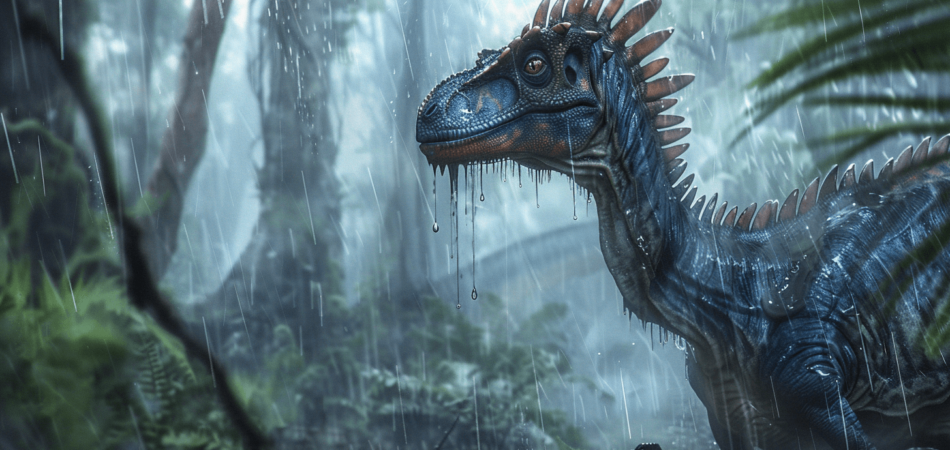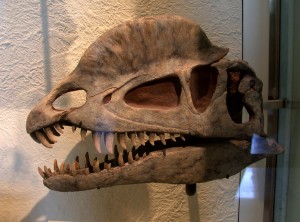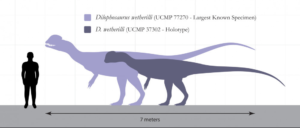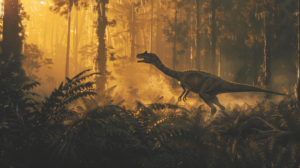Aardonyx Guide:
Aardonyx was an early dinosaur that lived in South Africa about 200 million years ago.
Aardonyx was an early dinosaur that lived in South Africa about 200 million years ago.

Dinosaur fossils have been discovered on every continent, demonstrating that they exist in every ecosystem on the planet. During the Triassic period, the continents were united into a single supercontinent, Pangea. The continents gradually expanded across the globe to their present condition. Dinosaurs were a successful group of creatures that first appeared between 240 million and 230 million years ago. They eventually came to govern the planet until a massive asteroid blasted into Earth 66 million years ago that scientists thought caused the mass extinction of dinosaurs and other animals.
In this article, we’ll discuss everything about the dinosaur Dilophosaurus and some misconceptions about it. We’ll explore its unique features, behavior, and habitat, as well as its significance in the dinosaur family tree. Additionally, we will address some popular myths, particularly the erroneous portrayal of Dilophosaurus in popular media. While we dive into these discussions, it’s also intriguing to compare its traits with those of other prehistoric reptiles, such as the elasmosaurus physical characteristics, which highlight the diversity of adaptations among ancient creatures.
Dilophosaurus was a theropod and also one of the biggest dinosaurs of the Early Jurassic Period (roughly 193 million years ago) and often presented as an iconic dinosaur. It was initially identified as Megalosaurus wetherilli, a new species in the already-existing genus, by the paleontologist Samuel P. Welles, a member of the team that discovered the dinosaur remains. The first Dilophosaurus skeletons were found in Northern Arizona in the 1940s, then in 1964, Welles found another specimen—a bigger skeleton from the same species. In 1970, he classified the species and named Dilophosaurus wetherilli after realizing it is a crested dinosaur. The species name acknowledges John Wetherill, a Navajo councilor, while the genus name refers to a “two-crested lizard.”
Also, in 1987, a suspected specimen was discovered in the Yunnan Province, leading some to speculate that Dilophosaurus lived and existed in China. Some people think this species is more closely related to Cryolophosaurus, an Antarctic theropod because it displays significant anatomical variations in skull construction. In 1993, Shaojin Hu gave this possible Dilophosaurus specimen the name Dilophosaurus Sinensis.

Crested Cryolophosaurus, often considered a close relative of Dilophosaurus, has a skeleton that has been meticulously rebuilt.
The Dilophosaurus is perhaps best known to viewers of the Jurassic Park franchise, a 1993 Steven Spielberg-directed science fiction movie (an adaptation of the novel version of the same name by Michael Crichton) as the frilled dinosaur that could spew venom at its prey. However, the real Dilophosaurus was significantly unlike this.
Most people are familiar with the cinematic Dilophosaurus as a kind of frilled dinosaur that has venomous spit. According to Steven Spielberg, the frill and the dinosaur trait to spit poison were created as a form of creative license, and the size decrease was done to make it easier for those who aren’t dinosaurs enthusiasts to distinguish Dilophosaurus from Velociraptor.
These changes may have made for a good Hollywood movie. Still, unfortunately, it has caused a significant amount of confusion among the non-scientific community as to what this specimen really looked like. So if you think the one you have seen in Jurassic park movies is the real Dilophosaurus, then you’re probably wrong.
The first Dilophosaurus fossils were uncovered in 1940 from the lower and middle part of the Kayenta Formation in Navajo Nation land close to Tuba City, Arizona, by a Navajo man named Jesse Williams. Samuel Welles, a paleontologist at the University of California, Berkeley, was one of the experts Williams exhibited the fossil evidence to in 1942 and was classified by Welles as a megalosaur (a superfamily of therapod dinosaurs). The earlier Dilophosaurus specimen found that time didn’t show to be a crested dinosaur, but later, in 1970, after observing it to have a head crest, he called it a new genus with the name Dilophosaurus. It is a combination of the Greek words di, which means “two,” lophos, which means “crest,” and sauros, which means “lizard.”
A Dilophosaurus-sized dinosaur’s footprints from the Early Jurassic were found in many locations, and now paleontologists had a body to study. Despite all of these changes, Dilophosaurus wetherilli came to represent the greatest Jurassic carnivores.
In 1984, Welles published a thorough paleontological description of Dilophosaurus, leaving out the specimen from 1964 because he believed it belonged to a different genus. The first known theropod from the Early Jurassic, Dilophosaurus, is still one of the most well-preserved fossils from that period.
Based on the then-known fossils, particularly specimen UCMP 77270, which had lain unstudied since 1964, paleontologists Timothy B. Rowe and Adam D. Marsh spent time thoroughly redrew the outline of Dilophosaurus in 2020. Additionally, they relocated the same quarry with the aid of Jesse Williams’ relative and removed a few previously ascribed Dilophosaurus specimens that they found too fragmented to identify. In an interview, Marsh referred to Dilophosaurus as the “most worst-known dinosaur” because, despite being found 80 years earlier, nothing was known about the creature. Marsh spent seven years examining the fossil evidence to resolve the dinosaur’s mysteries, including two specimens discovered two decades earlier by Rowe, his Ph.D. adviser.
Dilophosaurus, a medium-sized theropod, is one of the earliest giant predatory dinosaurs, but it was small compared to some of the later theropods. In the Early Jurassic, it was also the biggest known terrestrial animal in North America.

Image Courtesy of Flickr User stevelewalready
While the Dilophosaurus was known for its signature two crests, they may have actually appeared differently than we believe since they more than likely were covered in muscle and skin. The purpose of its head’s crests is unknown, although given its relatively frail skull and simple crests, they are unlikely to be utilized for fighting or defense. On the other hand, it may have been employed for sexual or dominant displays. Its head was proportionate to its body size; however, its skull was fragile. Additionally, the skull featured a thin snout with a gap between the nostrils. It had long, thin, curved teeth that were excellent for grabbing and wounding prey.
It had a long neck compared to other meat-eating animals, but not as long as a sauropod. It has a light, thin bone, just like those of modern birds. The vertebrae of the Dilophosaurus contained air sacs that developed into them, and it had 45 caudal (tail) vertebrae, 10 cervical (neck) vertebrae, and 14 dorsal (back) vertebrae.
The Dilophosaur’s arms appeared thin and fragile, yet they were strong due to their lengthy upper arm bones. They possessed four fingers, the first of which bore a sizable claw. The feet featured huge claws and massive, muscular thigh bones, which, if combined, make it an incredible and agile hunter.
Dilophosaurus was one of the largest carnivores that existed in North America during the Early Jurassic. This dinosaur would have depended largely on a keen sense of smell to make up for its lack of stereo vision as it did not have forward-facing eyes. It has been believed that, like Spinosaurus, Dilophosaurus may have consumed fish. This argument is supported by similarities between the bigger predator and modern Gharials, which also feed fish.
Welles thought and discovered that Dilophosaurus lacked a strong bite because of the gap in its upper jaw. The “subnarial gap,” as it is known, is formed by the intersection of two separate jaw bones that bear teeth. Welles thought that instead of biting, it utilized its front teeth for pulling and ripping and its rear teeth for piercing and slicing. It appears from the form of the skull and the presence of stronger teeth in the back that it would manipulate its food with the first bite and finish it after it had gotten far enough into the mouth, whether it consumed fish or terrestrial prey.
There is debate among scientists on what exactly Dilophosaurus eats. This dinosaur possibly consumed carrion in addition to small animals, which is likely what they were eating. If these dinosaurs also hunted large prey, researchers are still unsure and need further study. Based on the design of their teeth and their surroundings, the most recent theory claims that they mostly consumed sea creatures.
Dilophosaurus was the largest terrestrial animal known to have lived in North America at the time, in 1940, with a length of over 7 meters and a weight of about 400 kilograms. It was one of the earliest large carnivorous dinosaurs. Its size was between a T-Rex and the ferocious Velociraptor. They were fast and large at the same time. This dinosaur would have been similar in size to a brown bear but with a much longer and more powerful tail. The long stiff tail of this dinosaur would have counterbalanced its lengthy body and provided a way to turn fast without losing equilibrium.

From the diagram above, it is clear that an adult Dilophosaurus would be far larger than the average human.
There is no proof that any dinosaurs had frills, but the Dilophosaurus seen in the Jurassic Park movies has a frill that extends out from behind its skull in a frightening display to distract its victims as it strikes.
Dilophosaurus dinosaur may have appeared in the first Jurassic Park movie and was portrayed as one that spit venom and has a frill (comparable to a frilled lizard that may stretch around its neck). However, the existence of venom glands and frills on the real animal, Dilophosaurus, is not supported by any evidence, despite the fact that these things make for fascinating movie scenes.

Dilophosaurus became renowned as the poison-spitting dinosaur after its depiction in Jurassic Park, despite being a characteristic created for imagination. Once more, there is no proof that real Dilophosaurus could spit venom or that other dinosaurs were poisonous or toxic. It would be exceedingly challenging to document something like this in the fossil record!
But although Dilophosaurus undoubtedly lacked a frill and was unable to spit venom as it did in the film, the geologist J. Bret Bennington observed in 1996 that despite these facts, it is possible that its bite was poisonous, similar to the Komodo dragon. He concluded that giving the dinosaur poison was just as acceptable as giving it an unknown color for its skin.
Although the information you were informed about this particular species of dinosaurs at the time was unreliable, you now know that they were among the theropods that were the fastest and strongest during the early Jurassic Period. In addition, some paleontologists believe that these dinosaurs may have had warm blood, which ties to the intriguing evolution of endothermy that has occurred several times throughout the history of life on Earth.
Most of our understanding of Dilophosaurus dinosaurs derives from the fossils obtained on Navajo Nation land, thanks to Jesse Williams, a Navajo man, who was the first person in documented history to see the earlier specimens of a Dilophosaurus skeleton in 1940. It’s also possible that Dilophosaurus will offer important hints about how dinosaurs and modern birds evolved. As new fossils are discovered, we may learn more about their prehistoric lifestyle million years ago and present avian existence, helping close any information gaps about these dinosaur groups.